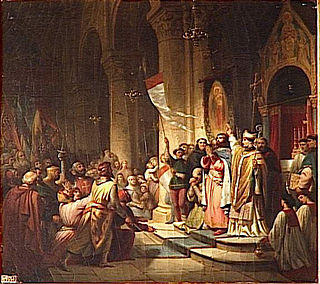External links
- "William di Monferrato" biography in The First Disciples of Saint Dominic
William of Montferrat (in Italian, Guglielmo di Monferrato) was probably a member of the family of the Marquesses of Montferrat.
As a young man, staying in the house of Ugolino de' Conti while observing Lent in Rome in 1215 or 1216, he encountered Dominic of Osma. They discussed Christian ministry, and talked of future missionary work among Prussians or other northern pagans. William afterwards spent two years at the University of Paris. In June 1219 Dominic came to Paris and enrolled William in the Order of Friars Preachers. Leaving Paris in July, Dominic and William travelled with a third Friar, known only as John (Iohannes), to Milan and Bologna. Leaving John there, they went on to Florence and Viterbo, where they found Pope Honorius III. William now remained with the Pope and gained his close trust, but was at Bologna in summer 1221 when Dominic died. He was one of the witnesses at the process of Dominic's canonisation at Bologna in 1233.

Fra Angelico, OP was a Dominican friar and Italian painter of the Early Renaissance, described by Giorgio Vasari in his Lives of the Artists as having "a rare and perfect talent". He earned his reputation primarily for the series of frescoes he made for his own friary, San Marco, in Florence, then worked in Rome and other cities. All his known work is of religious subjects.

Boniface I, usually known as Boniface of Montferrat, was the ninth Marquis of Montferrat, a leader of the Fourth Crusade (1201–04) and the king of Thessalonica.

Hyacinth was a Polish Dominican priest and missionary who worked to reform women's monasteries in his native Poland. He was a Doctor of Sacred Studies, educated in Paris and Bologna.

Guido Reni was an Italian painter of the Baroque period, although his works showed a classical manner, similar to Simon Vouet, Nicolas Poussin, and Philippe de Champaigne. He painted primarily religious works, but also mythological and allegorical subjects. Active in Rome, Naples, and his native Bologna, he became the dominant figure in the Bolognese School that emerged under the influence of the Carracci.
William of Montferrat, also called William Longsword, was the count of Jaffa and Ascalon, the eldest son of Marquess William V of Montferrat and Judith of Babenberg. He was the older brother of Conrad, Boniface, Azalaïs, and Renier, and a cousin of both Emperor Frederick I and King Louis VII of France.

Saint Dominic,, also known as Dominic de Guzmán, was a Castilian Catholic priest, mystic, the founder of the Dominican Order and is the patron saint of astronomers and natural scientists. He is alternatively called Dominic of Osma, Dominic of Caleruega, and Domingo Félix de Guzmán.
Rainier or Renier, son of William IV, Marquis of Montferrat, was the sixth ruler of the state of Montferrat in north-west Italy from about 1100 to his death, and the first such to be identified in contemporary documents as Margrave of Montferrat.

Angelus of Jerusalem, OCarm was a Catholic convert from Judaism and a professed priest of the Carmelites. He and his twin brother were converted to the faith once their mother did. Both went on to become ordained priests and Carmelite friars. Unlike his brother, however, he retreated into the desert to a hermitage after his ordination, but he emerged once he was instructed to go to the Italian mainland to evangelize as well as to meet with Pope Honorius III to have him approve a new rule for the Carmelites.

Casale Monferrato is a town in the Piedmont region of Italy, in the province of Alessandria. It is situated about 60 km (37 mi) east of Turin on the right bank of the Po, where the river runs at the foot of the Montferrat hills. Beyond the river lies the vast plain of the Po valley.

John of Wildeshausen, O.P., also called Johannes Teutonicus was a German Dominican friar, who was made bishop of Bosnia and later the fourth master general of the Dominican Order.
John of Vercelli was the sixth Master General of the Dominican Order (1264-1283).

Niccolò dell’Arca was an Italian Early Renaissance sculptor, who worked mostly in terracotta. He is also known under the names Niccolò da Ragusa, Niccolò da Bari and Niccolò d'Antonio d'Apulia. The surname “dell’Arca” refers to his contribution to the Arca di San Domenico.
Demetrius or Demetrios of Montferrat was King of Thessalonica from 1207 to 1224.

The Arca di San Domenico is a monument containing the remains of Saint Dominic. It is located in Dominic’s Chapel in the Basilica of San Domenico in Bologna, Italy.
Reginaldof Bologna was the Archbishop of Armagh and Primate of Ireland from 1247 until his death. He was highly praised by Humbert de Romans, Bernard Gui, Antonio Pierozzi, Leander Alberti, and Thomas Malvenda in his Annals.

John George of Monferrat was the last Marquis of Montferrat of the Palaeologus-Montferrat family.
Boniface III Palaeologus was Marquis of Montferrat from 1483 until his death.

Boniface IV Paleologo, Marquis of Montferrat was an Italian nobleman. He succeeded his father William IX, Marquis of Montferrat from 1518. His mother was Anna d'Alençon (1492–1562).

The House of Palaeologus-Montferrat or Palaiologos-Montferrat, or just Palaeologus or Paleologo, was an Italian noble family and a cadet branch of the Palaiologos dynasty, the last ruling family of the Byzantine Empire. The cadet branch was created in 1306 when Theodore Palaiologos, fourth son of Byzantine Emperor Andronikos II Palaiologos, inherited the March of Montferrat through his mother, and Andronikos II's second wife, Yolande of Montferrat.